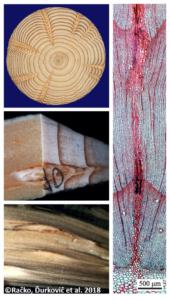By AFS On 22 August 2018 In All published articles, Open Access, Research paper
 Fungal infection was outlined as a potential reason for the onset of indented annual growth ring formation during the juvenile phase of hazel wood growth. Annual growth ring indentations resulted from the formation of disturbed zones which originated solely in close proximity to leaf traces.
Fungal infection was outlined as a potential reason for the onset of indented annual growth ring formation during the juvenile phase of hazel wood growth. Annual growth ring indentations resulted from the formation of disturbed zones which originated solely in close proximity to leaf traces.
Context Hazel wood is an abnormal type of woody tissue that is formed as a result of exogenous stimuli that may trigger long-term responses in the cambium. Cambial responses produce anatomical alterations in the surrounding xylem tissue that can be observed as an indentation of annual growth rings. The chemical profiles of lignan hydroxymatairesinol may provide an indication of its possible role in the protection of a living tree against the spread of a fungal or microbial infection at the onset of indentation.
Aims The objectives of this study were to reveal the anatomical differences in the altered woody tissue of Picea abies hazel wood at both the onset and the later stages of annual growth ring indentation and to determine the chemical profiles for hydroxymatairesinol upon elicitation by a fungal infection in the disturbed zones.
Methods Light and scanning electron microscopy observations were carried out on radial, tangential, and cross sections of hazel wood zones separated from P. abies stems. Concentrations of hydroxymatairesinol were determined for both the disturbed zones and the non-indented zones using a gradient high-performance liquid chromatography.
Results The formation of disturbed zones was accompanied by significant changes in both the direction and width of the tracheids which produced an abnormal formation of intertwined and twisted tracheids. Fungal hyphae, radial cell wall cracks, and unusually large cross-field pitting were all found in the tracheids of the disturbed zones.
Conclusion The content of hydroxymatairesinol in the acetone extract determined from the disturbed zones was 3.4 times greater than that present in the non-disturbed tissues. By means of vascular dysfunction in the leaf traces, host trees responded to the fungal infection by plugging the lumens of conductive leaf trace tissue and filling the vascular pathway with polyphenolic compound deposits.
Keywords
Disturbed zone, Fungal infection, Hydroxymatairesinol, Indented annual growth ring, Leaf trace
Open Access Publication
Račko, V., Kačík, F., Mišíková, O. et al. Annals of Forest Science (2018) 75: 82.
https://doi.org/10.1007/s13595-018-0757-z
Source: https://ist.blogs.inra.fr/afs/
Original article: https://ist.blogs.inra.fr/afs/2018/08/22/the-onset-of-hazel-wood-formation-in-norway-spruce-picea-abies-l-karst-stems/
